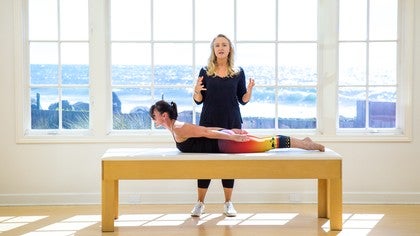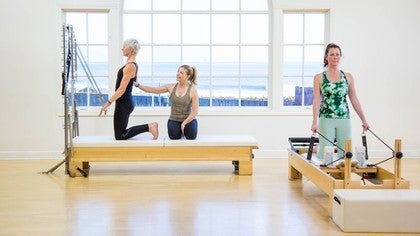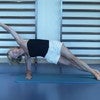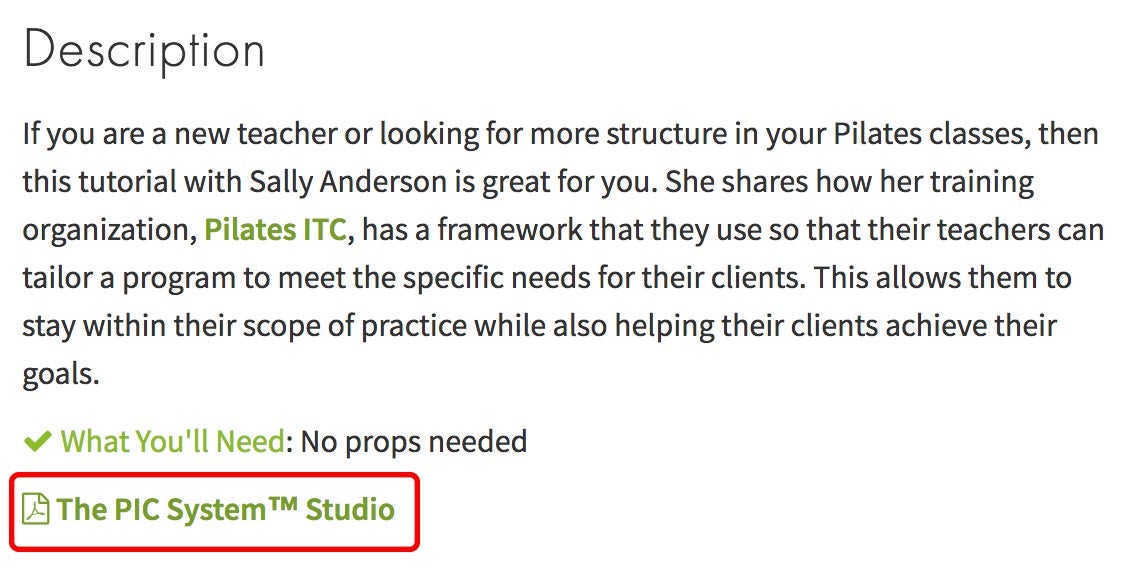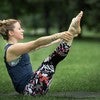Description
About This Video
Transcript
Read Full Transcript
Hello, I'm Sally Anderson from PilatesITC, all the way from down under in Australia. So, PilatesITC is a government-registered training organization, and we deliver government accredited courses. So, in relevance to this today, I'm going to talk to you about one of the primary aspects of those courses which is the programming system. So, in early 2004, we accredited our courses after a three year process. Now, not just for bragging rights, but this is relevant to what I'm talking to you about today.
So, in that process, which did take three years, we were audited and our courses assessed by a panel of experts that included not only Pilates experts, of course, but allied health, fitness, and medical experts, who formed a board that took quite an extensive time to look through the courses and assess them in alignment with minimum standards and educational requirements across sectors. So, the importance of this is that we need to fit within the scope of practice that interrelates with these fields. And that is a fundamental part of how we can move forward with accreditation and government recognition. To look at our scope of practices Pilates teaches, if we are going to interrelate with these other fields, and inevitably we do when we're looking at corrective work, postural correction, rehabilitation, and conditioning and fitness work, we do need to be relevant to exercise prescription that is reasoned and allowed to be creative in its thinking. So, we train our graduates to be able to reason their programming and service their clients, both their needs and their goals.
So, the needs of the client and the goal of the client are serviced by instructors being able to exercise select appropriately and prescribe a program that will achieve those goals and fulfill those needs. So, in order to fulfill this need to be able to exercise prescribe and give our graduates a structure and a framework with which they can do this, we have the Pilates International Category System, commonly known as the PIC System. So, this is a systemized approach to programming. We teach the PIC System. I know other approaches in the Pilates world have their own systematic approaches to programming.
I started out with Rael Isacowitz with BASI Pilates, and they have a block system, very much the same thing. What these systems provide is a framework that can allow you to file and record the repertoire, make exercise selections according to the categories or the blocks within the systems, and fulfill the tailoring of a program to specific client needs. These can also be quite flexible. So, once you've taken onboard the programming system that you choose to take on and understand how to file, record, and exercise select in these categories, then you're able to move with it and create kind of a dance. It's like the human body.
The bones stay the same, but they move in all different directions. And that's what we can do with these systemized approaches to programming while not losing track of where we are in a program. Now, if you look below the screen, there is a link that you can click on and download the PIC System, which is the approach to programming that we use with our PilatesITC students and graduates, and something that they always come back to us and tell us how much it supports their work in the studio. We also have the Mat Work PIC System, but today I'm really going to focus on the studio as something that we can all take onboard with clients ranging from your conditioning, or like quite healthy clients, right through to rehabilitation. So, if you look at that document that you've now downloaded, there are 14 categories in that PIC System.
Starting from the warm-up, going into leg and foot work, and then ranging through some specific areas or regions of the body and different reasonings for why you would need to focus on specific exercise selections in those categories. So, for now, take to heart that we have 14 categories there. You are going to be able to file and record your exercises in those categories. And being able to select according to the goals or the reasoning of those categories and the amount of exercises that you might use in each of those categories, that will create a program for you or for your clients. So, there's the starting point.
Now, the PIC System addresses the entire body, addresses mind and breath within the program, utilizes all ranges of movement, gives a familiarity of sequences, and builds from basic to more challenging, both in the categories and in the overall program. So, by the time you've moved through all those categories and integrated your exercise selections according to the goal, that's the type of program you should have for your client. There's a couple of key categories I'd like to look at. So, in particular the warm-up. Okay, so the warm-up is one of my key categories in the programming system.
For me, the warm-up not only provides preparation for the body, which my concept underpinning that preparation for the body in the warm-up category is release and activation. So, I'm looking for the exercise selections that will give release to movement patterns that are overutilized in day-to-day life, habitual compensatory patterns. We want to kind of get those out of the way and be able to activate the muscle groups or muscles that we want to bring more into play, things that are getting left behind in day-to-day life. So that starting point of just preparation in that first category allows us to then, second point, bridge from outside to inside the studio. So, from day-to-day life outside, we wanna take that client, bring them into the studio, and give them a better opportunity to get better movement patterns, achieve more progression in the program, which is a very big part of what that PIC System will allow you to do is progress.
This will also give us a category where we're constantly able to evaluate how the client's moving and how they're progressing. So, I see it as a consistent assessment tool every time we do the program. The fourth point that really supports this being a key category for me is that it becomes exercises or a homework plan. So, the warm-up is where I wanna really create release and activation, preparation for the client, bridge them from their outside life to inside the studio, get the most out of the rest of the program from having done this, and then be able to filter that into their homework or home exercise program. So, from the warm-up, we then continue into the programming to leg and foot work.
So, we're in the studio. This isn't the mat work variation. But in the studio we go from warm-up into leg and foot work, which for me is still pulling that preparation into the rest of the program. So, we've really done our initial release, activation, prepare the client for better movement patterns and better function, and then the leg and foot work brings in a bit more of a global perspective to that. We use those leg muscles to get blood circulating, oxygen circulating.
It's closed chain. We're grounding through the legs into the pelvis and really giving the client a sense of how to go forward in the program. So, those two categories, while warm-up is particularly key for me, take it into the leg and foot work is still my preparation, still building you into the rest of the program. So, from there, after that preparation and leg and foot work, we move into various categories that you'll see down your program, come to various regions of the body and different functions. So, we'll look at closed chain work, open chain work, bringing in various principles of corrective work that allow us to track through the body with specific focus in specific categories and build towards our greater challenge when the body's really prepared for it.
While we're still just focusing on the warm-up category as preparation, I wanted to spend a little moment having a look at the way we would progress in a category. So, it becomes quite easy to see your progressions in the warm-up. Starting with a new client or a client who's at a more basic or early level, where we would begin with a foundation series using things like spinal articulation, pelvic curls, perhaps, spinal mobilization, we often use a side to side process, chest lifts, single leg lifts, hula, things that start to teach the client how to mobilize certain joints, engage certain muscle groups. But we're at an earlier level. That progression should take place in the warm-up as it does in every other category of the program.
So, at a later level, we'd be looking at having tracked those exercises through to a higher level challenge that the client is then ready to take on. So, that might be pelvic curls, side to side with a lever, so your lever becomes an added challenge or a progression. Taking it into single leg stretches, crisscross, assisted roll ups. We may go into a rollover, if the client requires more flexion-based work or perhaps into a stronger, maybe loaded, spinal extension work if we're trying to set up that work through the extenses or correct posture, those sorts of things. So, we will always try and take those steps forward in progression in each category, and the idea of that progression is to do it a step at a time.
Same as with regression, I talk about taking steps backward, just a step, so you don't take the challenge level too far back. And that becomes even more relevant as we move through the program. And wind up, if you look on your PIC System sheet, with a full body challenge or a client-specific challenge toward the end of the program. So, we've used that middle section of the program, as you can see, with the abdominal work, which ideally we're going to build endurance in, leg strap work, open chain hip work in that category, taking it through hip function, arm work, lateral flexion, torso extension. I know I jumped a couple there, but you get the sense of that program.
Building us to where we are really going to give the client some motivation. Now, this is important so if we're wanting those clients to come back and be progressing toward a healthier life, toward their goals. Wanting to be able to take the Pilates method on is something that is their lifestyle and their way of achieving health and fitness. Then we want to be able to motivate them. A real easy way of motivating through this programming is to build towards that category that is client-specific and find that challenge level for your client.
Now, finding that challenge level for a client is one of the things that probably comes with experience, but you can learn it. And it really, it's a thought process that will help you keep trying to find where your client is perfectly pitched. And I think this is a big part of how a client is motivated to continue and to really wanna be there. So, it solves a lot of business issues as well when you get that client really wanting to be there. So, in your categories if you've made good exercise selections from the exercises that fit those goals in the programming, by the time you get to the client-specific or body challenge at the end, you wanna be able to nail those exercise selections in that category that make your client feel like they have really achieved something this session.
And that session becomes every session. The idea of going through a Pilates workout, and we've probably all done this, where you leave and you go, "Well, that was nice, "but I don't particularly feel overly challenged. "You know, I might go back." We don't want that. The other alternative to that is that you come out of a session where you've been pushed so far past your challenge level that you feel like everything's had to compensate to get you there. We don't want that.
Neither of those areas bring your client back. Neither of those areas feel good to us. What we want to try and target is that absolute point of challenge for your client, where they are energized, inspired. It has changed the way their body moves by the end of the program, and they've achieved something. So, that sense of achievement should be what that last or second to last category, the body challenge category, is about.
And it might be client-specific in terms of addressing their need for rehabilitation or correction. Maybe it's a shoulder exercise, an integrated support exercise for somebody who's working on their shoulder stability or strength. Or it might be the Teaser series. Or it might be some Hanging on the Cadillac that really makes that client feel like, "I have changed my body. "My brain is involved.
"I'm inspired, I'm energized, "and I'm leaving this class feeling "like I have achieved something." And that for me is the outcome of the program. Yes, we have our release or warm-down from there, which just nicely calms the client back down and brings them back to re-entering the world. But they're re-entering with the sense of achievement and a whole body workout that has been tailored specifically for them. And that is really the crux of having a systematic program approach that becomes very simple. So, it just is a framework that supports your exercise prescription.
So, then if you bring that back to what I was discussing at the beginning. In terms of being able to feel like our scope of practice is definitely integrated with all the other fields and modalities that we do work with, and we want to work with. And they are amazing practitioners that feed us as well as we feeding them. We do need to work with systems and processes that are recognized across those fields, and recognized as current ways in which a practitioner can prescribe exercise in a tailored needs and goals based way that provides function and challenge for our clients. Now, if you'd like to learn more about programming across any approaches, I'm really happy to provide resources or recommendations.
You can contact me through Pilates Anytime, and I'd be very happy to put you in touch with more work.
The Teacher's Corner: Teaching Tools
Comments
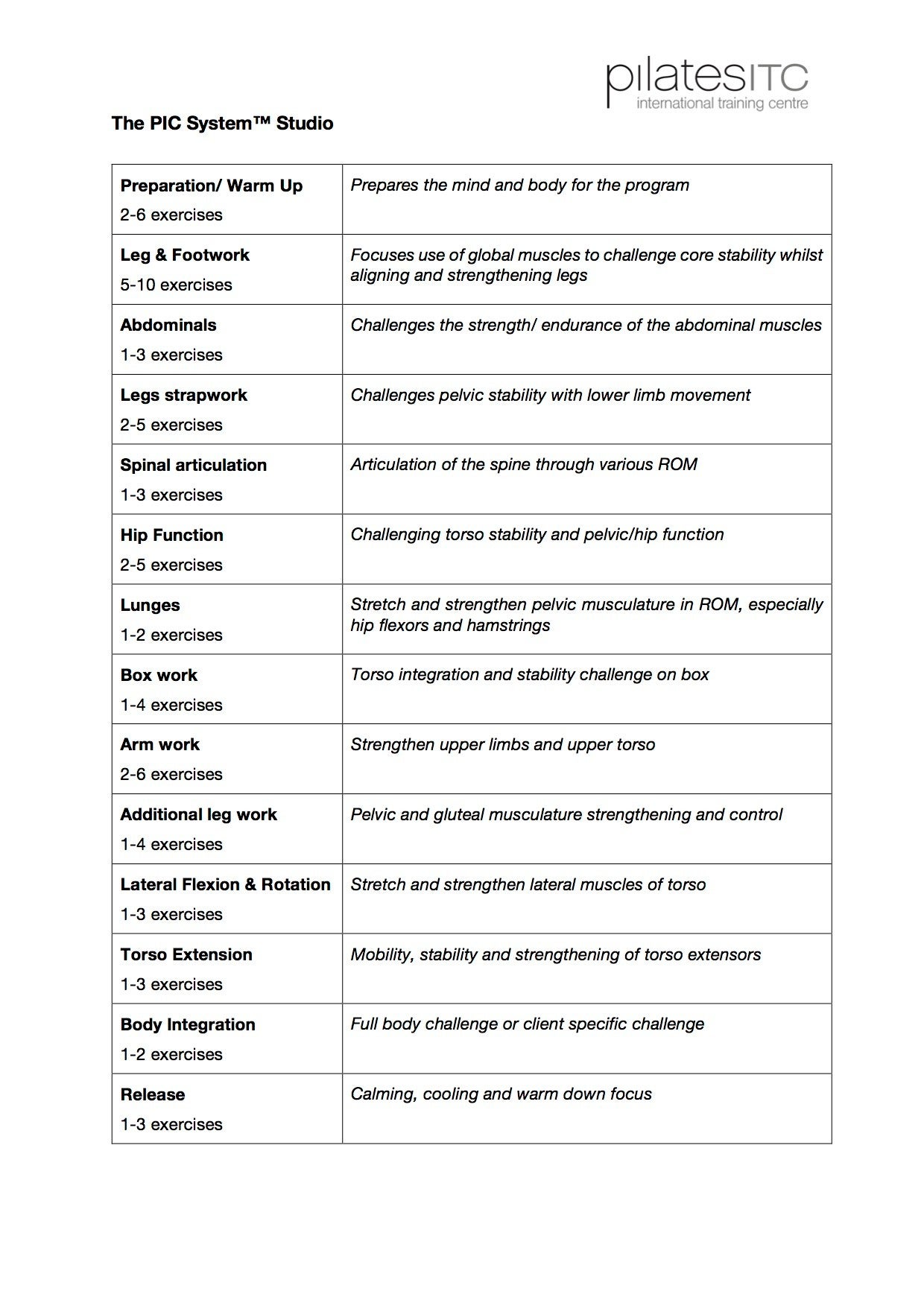
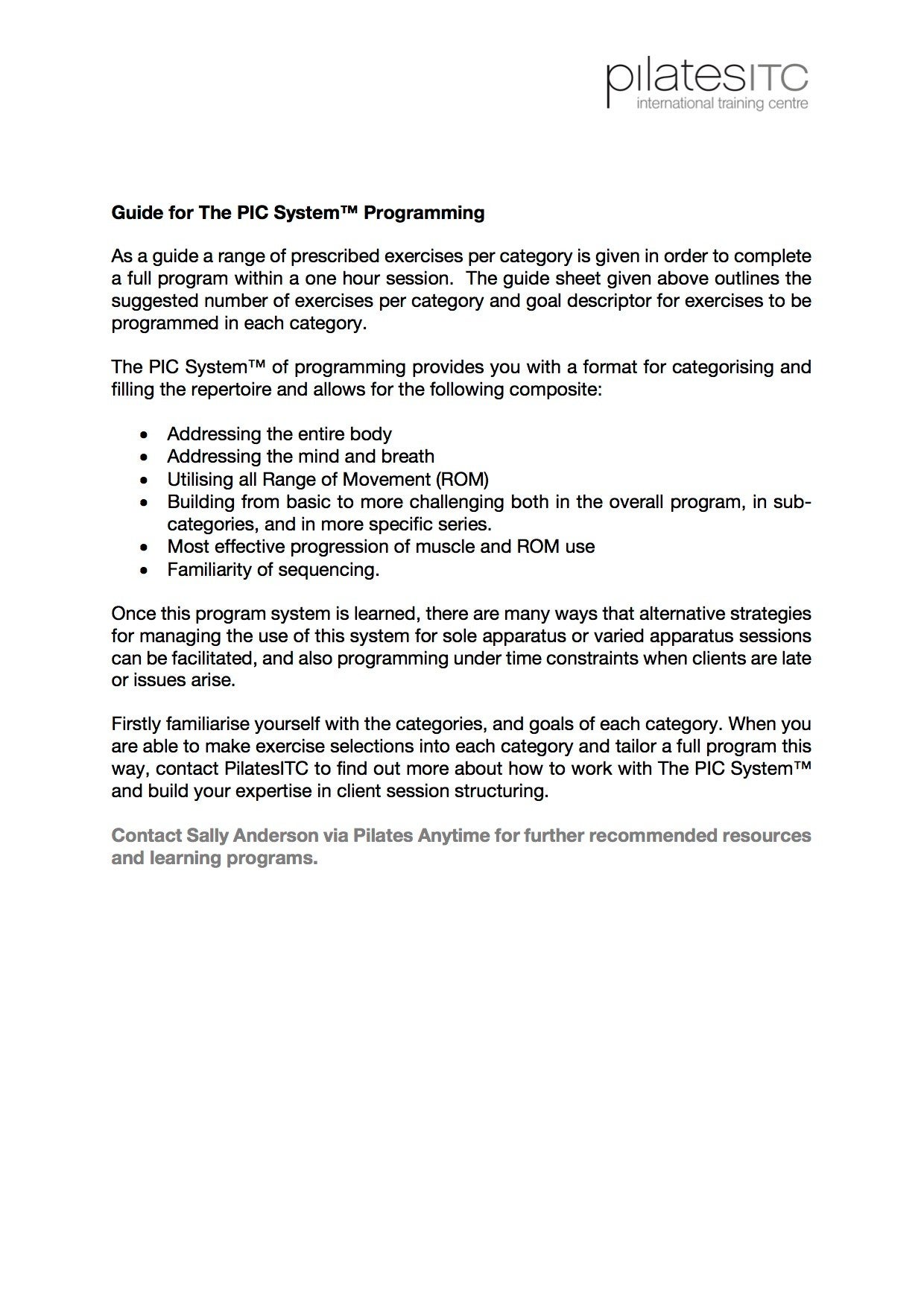
Please could you share the Matwork system with us?
You need to be a subscriber to post a comment.
Please Log In or Create an Account to start your free trial.
